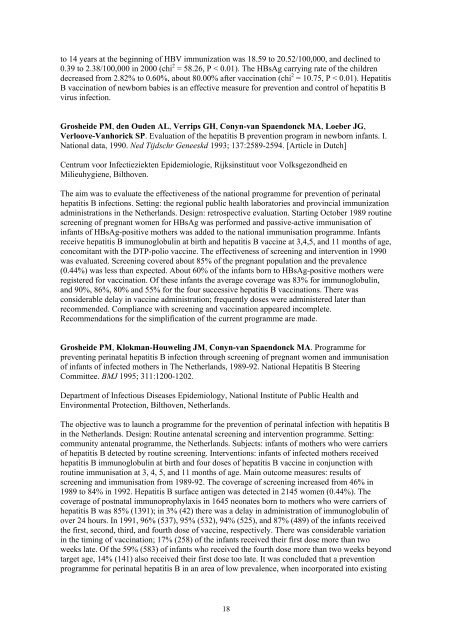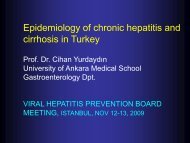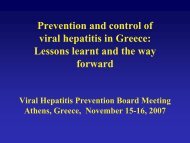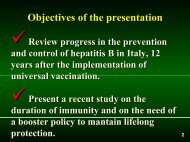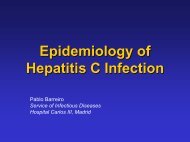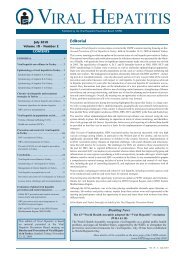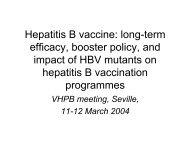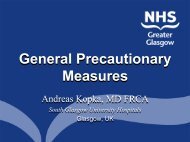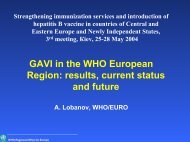Prevention and control of perinatal hepatitis B virus transmission in ...
Prevention and control of perinatal hepatitis B virus transmission in ...
Prevention and control of perinatal hepatitis B virus transmission in ...
Create successful ePaper yourself
Turn your PDF publications into a flip-book with our unique Google optimized e-Paper software.
to 14 years at the beg<strong>in</strong>n<strong>in</strong>g <strong>of</strong> HBV immunization was 18.59 to 20.52/100,000, <strong>and</strong> decl<strong>in</strong>ed to0.39 to 2.38/100,000 <strong>in</strong> 2000 (chi 2 = 58.26, P < 0.01). The HBsAg carry<strong>in</strong>g rate <strong>of</strong> the childrendecreased from 2.82% to 0.60%, about 80.00% after vacc<strong>in</strong>ation (chi 2 = 10.75, P < 0.01). HepatitisB vacc<strong>in</strong>ation <strong>of</strong> newborn babies is an effective measure for prevention <strong>and</strong> <strong>control</strong> <strong>of</strong> <strong>hepatitis</strong> B<strong>virus</strong> <strong>in</strong>fection.Grosheide PM, den Ouden AL, Verrips GH, Conyn-van Spaendonck MA, Loeber JG,Verloove-Vanhorick SP. Evaluation <strong>of</strong> the <strong>hepatitis</strong> B prevention program <strong>in</strong> newborn <strong>in</strong>fants. I.National data, 1990. Ned Tijdschr Geneeskd 1993; 137:2589-2594. [Article <strong>in</strong> Dutch]Centrum voor Infectieziekten Epidemiologie, Rijks<strong>in</strong>stituut voor Volksgezondheid enMilieuhygiene, Bilthoven.The aim was to evaluate the effectiveness <strong>of</strong> the national programme for prevention <strong>of</strong> <strong>per<strong>in</strong>atal</strong><strong>hepatitis</strong> B <strong>in</strong>fections. Sett<strong>in</strong>g: the regional public health laboratories <strong>and</strong> prov<strong>in</strong>cial immunizationadm<strong>in</strong>istrations <strong>in</strong> the Netherl<strong>and</strong>s. Design: retrospective evaluation. Start<strong>in</strong>g October 1989 rout<strong>in</strong>escreen<strong>in</strong>g <strong>of</strong> pregnant women for HBsAg was performed <strong>and</strong> passive-active immunisation <strong>of</strong><strong>in</strong>fants <strong>of</strong> HBsAg-positive mothers was added to the national immunisation programme. Infantsreceive <strong>hepatitis</strong> B immunoglobul<strong>in</strong> at birth <strong>and</strong> <strong>hepatitis</strong> B vacc<strong>in</strong>e at 3,4,5, <strong>and</strong> 11 months <strong>of</strong> age,concomitant with the DTP-polio vacc<strong>in</strong>e. The effectiveness <strong>of</strong> screen<strong>in</strong>g <strong>and</strong> <strong>in</strong>tervention <strong>in</strong> 1990was evaluated. Screen<strong>in</strong>g covered about 85% <strong>of</strong> the pregnant population <strong>and</strong> the prevalence(0.44%) was less than expected. About 60% <strong>of</strong> the <strong>in</strong>fants born to HBsAg-positive mothers wereregistered for vacc<strong>in</strong>ation. Of these <strong>in</strong>fants the average coverage was 83% for immunoglobul<strong>in</strong>,<strong>and</strong> 90%, 86%, 80% <strong>and</strong> 55% for the four successive <strong>hepatitis</strong> B vacc<strong>in</strong>ations. There wasconsiderable delay <strong>in</strong> vacc<strong>in</strong>e adm<strong>in</strong>istration; frequently doses were adm<strong>in</strong>istered later thanrecommended. Compliance with screen<strong>in</strong>g <strong>and</strong> vacc<strong>in</strong>ation appeared <strong>in</strong>complete.Recommendations for the simplification <strong>of</strong> the current programme are made.Grosheide PM, Klokman-Houwel<strong>in</strong>g JM, Conyn-van Spaendonck MA. Programme forprevent<strong>in</strong>g <strong>per<strong>in</strong>atal</strong> <strong>hepatitis</strong> B <strong>in</strong>fection through screen<strong>in</strong>g <strong>of</strong> pregnant women <strong>and</strong> immunisation<strong>of</strong> <strong>in</strong>fants <strong>of</strong> <strong>in</strong>fected mothers <strong>in</strong> The Netherl<strong>and</strong>s, 1989-92. National Hepatitis B Steer<strong>in</strong>gCommittee. BMJ 1995; 311:1200-1202.Department <strong>of</strong> Infectious Diseases Epidemiology, National Institute <strong>of</strong> Public Health <strong>and</strong>Environmental Protection, Bilthoven, Netherl<strong>and</strong>s.The objective was to launch a programme for the prevention <strong>of</strong> <strong>per<strong>in</strong>atal</strong> <strong>in</strong>fection with <strong>hepatitis</strong> B<strong>in</strong> the Netherl<strong>and</strong>s. Design: Rout<strong>in</strong>e antenatal screen<strong>in</strong>g <strong>and</strong> <strong>in</strong>tervention programme. Sett<strong>in</strong>g:community antenatal programme, the Netherl<strong>and</strong>s. Subjects: <strong>in</strong>fants <strong>of</strong> mothers who were carriers<strong>of</strong> <strong>hepatitis</strong> B detected by rout<strong>in</strong>e screen<strong>in</strong>g. Interventions: <strong>in</strong>fants <strong>of</strong> <strong>in</strong>fected mothers received<strong>hepatitis</strong> B immunoglobul<strong>in</strong> at birth <strong>and</strong> four doses <strong>of</strong> <strong>hepatitis</strong> B vacc<strong>in</strong>e <strong>in</strong> conjunction withrout<strong>in</strong>e immunisation at 3, 4, 5, <strong>and</strong> 11 months <strong>of</strong> age. Ma<strong>in</strong> outcome measures: results <strong>of</strong>screen<strong>in</strong>g <strong>and</strong> immunisation from 1989-92. The coverage <strong>of</strong> screen<strong>in</strong>g <strong>in</strong>creased from 46% <strong>in</strong>1989 to 84% <strong>in</strong> 1992. Hepatitis B surface antigen was detected <strong>in</strong> 2145 women (0.44%). Thecoverage <strong>of</strong> postnatal immunoprophylaxis <strong>in</strong> 1645 neonates born to mothers who were carriers <strong>of</strong><strong>hepatitis</strong> B was 85% (1391); <strong>in</strong> 3% (42) there was a delay <strong>in</strong> adm<strong>in</strong>istration <strong>of</strong> immunoglobul<strong>in</strong> <strong>of</strong>over 24 hours. In 1991, 96% (537), 95% (532), 94% (525), <strong>and</strong> 87% (489) <strong>of</strong> the <strong>in</strong>fants receivedthe first, second, third, <strong>and</strong> fourth dose <strong>of</strong> vacc<strong>in</strong>e, respectively. There was considerable variation<strong>in</strong> the tim<strong>in</strong>g <strong>of</strong> vacc<strong>in</strong>ation; 17% (258) <strong>of</strong> the <strong>in</strong>fants received their first dose more than twoweeks late. Of the 59% (583) <strong>of</strong> <strong>in</strong>fants who received the fourth dose more than two weeks beyondtarget age, 14% (141) also received their first dose too late. It was concluded that a preventionprogramme for <strong>per<strong>in</strong>atal</strong> <strong>hepatitis</strong> B <strong>in</strong> an area <strong>of</strong> low prevalence, when <strong>in</strong>corporated <strong>in</strong>to exist<strong>in</strong>g18


